Road signs in Chile – Wikipedia
From Wikipedia, the free encyclopedia
Chile is a signatory to the Vienna Convention on Road Signs and Signals, and therefore its signs are compliant with international standards. Chile uses yellow diamonds for warning signs in common with most of the rest of the Americas. Speed limit signs are a red circle with a white background and the limitation in black, and are in kilometres per hour. There are also some signs unique to Chile. Chile also currently uses a mixture of both types of mandatory signs.
Chile drives on the right.
Formerly, Highway Gothic was the official typeface of Chile’s road signs. New Chilean road signs use Ruta CL, a font designed for Chile’s road signs.[1]
Road signs[edit]
Priority signs[edit]
The priority section includes three signs: Give Way, Stop, and Stop for Children. The give way sign indicates to drivers that they must slow down and give way to vehicles on the approaching road, but that they do not need to stop if there is enough room to join or merge. The stop sign indicates to drivers that they must come to a complete stop before joining the approaching road, and is reserved for situations where a raised risk of an accident exists if drivers were not to fully stop before proceeding. The stop for children sign is used by crossing guards, and indicates to drivers that they must come to a complete stop and wait while children cross the road.
Prohibitory signs[edit]
The prohibition section includes signs that are used to prohibit and limit certain vehicles from using the road or from making certain movements/actions. Prohibitions are indicated by a red circle with a 45 degree slash from left to right.
-

-

-

-

-

-

-

-

-

-

-
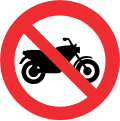
-

No tractors or other slow-moving vehicles
-

-

-

-

-

-

-

Restriction signs[edit]
The restriction section includes signs that are used to limit the use of the road based on certain characteristics of the road itself, such as limited height. This section also includes the “end of prohibition or restriction” sign which marks the end of any prohibitions and restrictions of the road.
-

Maximum speed limit (50 km/h)
-

Minimum speed limit (40 km/h)
-

-

Weight restriction (10 tonnes (11 short tons))
-

Weight restriction (2 tonnes per axle)
-
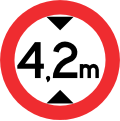
Height restriction (4.2 metres (14 ft))
-
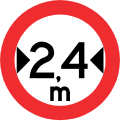
Width restriction (2.4 metres (7.9 ft))
-

Length restriction (no vehicles over 10 metres (33 ft) long)
-

End prohibition or restriction (in this case, the overtaking prohibition has ended)
Mandatory signs[edit]
The obligation section includes signs directing road users to directions and actions they must take or obey. This includes marking one-way streets, mandatory turns and lane control.
-

One-way street (leftwards)
-

One-way street (rightwards)
-

-

-

-

-

Give preference to vehicles coming from opposite direction (used at traffic bottlenecks)
-

Pedestrians walk on your left
-

-

-

-

Stop for customs checkpoint
-

-

-

Low-beam headlights required
-

-

Pedestrians and cyclists keep your side on path
-

Pedestrians and cyclists keep your side on path
-

-

Permission signs[edit]
The authorization section includes signs informing road users of actions that are allowed.
-
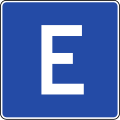
-

Right turn on red light permitted with caution
-

-

-

-

-

Winding road first curve to right
-

Winding road, first curve to left
-

Double curve first to right
-

Double curve first to left
-

Sharp Double curve first to right
-

Sharp Double curve first to left
-

-

-

-

-

-

-

-

Uneven road (with distance in metres)
-

-

Road narrows ahead on both sides
-

Road narrows ahead on right side
-

Road narrows ahead on left side
-

-

Road widens ahead on both sides
-

Road widens ahead on right side
-

Road widens ahead on left side
-

Weight restriction ahead (10 tonnes (11 short tons))
-
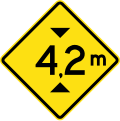
Height restriction ahead (4.2 metres (14 ft))
-

Width restriction ahead (2.4 metres (7.9 ft))
-

Length restriction ahead (vehicles over 10 metres (33 ft) long)
Intersection signs[edit]
-

Railway crossing ahead without gates or barriers
-

Railway crossing ahead with gates or barriers
-

-

Railway crossing with multiple tracks
-

-

-

-

-

-

Minor road ahead on right
-

Staggered crossroads, first to the left
-

Staggered crossroads, first to the right
-

-

-

-

-

Watch for farm vehicles crossing
-
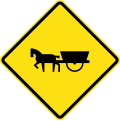
Watch for horse-drawn vehicles
-

-

-

-

Watch for Pedestrian crossing
-

-

-

Watch for children playing
-

-

-

Special signs[edit]
-

-

-

-

Danger of electrical wires
-

-

Unprotected waterfront or quayside
-

Airport or airfield nearby
-

-

-

Temporary signs[edit]
-

-

-

-

Watch for construction vehicles
Informative Signs[edit]
-

-
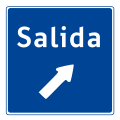
-

-

Countdown beacon to next exit (100 meters away)
-

Countdown beacon to next exit (200 meters away)
-

Countdown beacon to next exit (300 meters away)
-

-

-

-

-

-

-

-

-

-

-

-
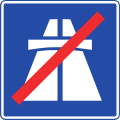
-

-
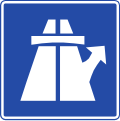
-

-

-

References[edit]
Manual de Señalización de Tránsito, Capítulo 2 (PDF), Comisión Nacional de Seguridad de Tránsito, retrieved 2019-08-04 Introducción Al Manual De Señalización De Tránsito (PDF), Municipalidad de Punta Arenas, retrieved 2019-08-04
Recent Comments